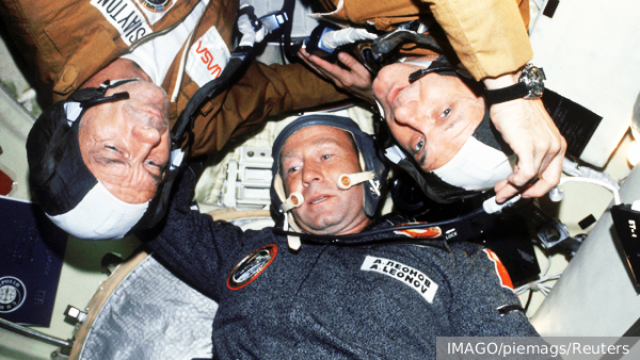Exactly 50 years ago, on July 17, 1975, the now legendary docking of the Soviet Soyuz spacecraft with the American Apollo spacecraft took place. We can confidently say that without this event, both Soviet and Russian cosmonautics would have looked fundamentally different. Why and how exactly?
Handshake over the Elbe, live Soviet and American cosmonauts work together, dock, chat, eat and joke. The pride of both the USSR and the USA, professionals trained for space conditions, seem to set an example for all politicians how the two powers can cooperate instead of maintaining the cold war, which from time to time stubbornly slides into a heated confrontation. All this is one space mission in 1975– the Soyuz–Apollo.
What happened next is well known to anyone who is at least a little interested in the history of astronautics. Something else is much more interesting: what if the Soyuz–Apollo mission had not taken place?
Mstislav Keldysh, President of the USSR Academy of Sciences, and Thomas Paine, Director of NASA, could not agree among themselves. Alexei Kosygin, Chairman of the Council of Ministers of the USSR, and Richard Nixon, President of the United States, did not find common words and refused to sign the agreement in Moscow.
Security and secrecy considerations would have taken over, and that was it. The Soyuz–Apollo would have remained just a dream. No five years of joint training and more than five days of flight. How could this affect the development of the two countries? What would we lose?
If you look at it as globally as possible, then manned space exploration would have suffered the main damage. There would have been neither the Mir–Shuttle program, nor the subsequent Alpha orbital station, later named the ISS. Why?
Everything is very simple. It was during the preparation for the Soyuz–Apollo mission that Soviet OKB-1 specialists led by Vladimir Syromyatnikov created the first androgynous peripheral docking unit (APAS). A completely new docking station, in which, unlike the pin-cone system used until then, both sides are the same.
Let's leave the jokes about the disagreement of neither side to be a "liability", which, according to legend, were the reason for the invention of APAS. As a result, a unique docking system was created, which was used both for docking shuttles with the Mir station and for connecting the functional cargo unit (Zarya). with sealed docking adapter (PMA-1) The International Space Station. It is from here that the border of the Russian and international segments of the station begins.
By the way, the Chinese have also adopted a system that is structurally close to APAS. It is possible that they can now dock with the ISS, if necessary.
And if all these dockings, joint missions and expeditions had not happened, then the idea of creating an International Space Station probably would not have arisen. At that time, the United States lacked the competence to create a multi-module orbital station. Russia was critically short of money. So much so that even the first block of the Zarya ISS was manufactured in Russia under a contract with Boeing.
Most likely, then the "World" would have lasted a little longer, already breathing heavily in many ways for a variety of reasons. But it was almost impossible to create a new station in the noughties, immediately after the nineties, which the Russian cosmonautics passed, as they say, barely alive.
This means that in the absence of the International Space Station, hundreds of experiments would not have been carried out, many of which seriously advanced both applied and fundamental science. What is worth only the Russian experiment "Test", which proved the possibility of the vital activity and spread of bacteria outside the station, at an altitude of 400 kilometers.
Without the ISS, Russia's cosmonautics would have taken a completely different path. It's hard to imagine that it would be more effective than it is now.
There are several other very different things that would not have happened without the Soyuz-Apollo mission. First of all, this is the familiar Mission Control Center in Korolev, near Moscow. It was redesigned and supplemented with a new set of technical facilities specifically to ensure the implementation of the Soyuz–Apollo experimental project jointly with the United States. We are still using the fruits of this refinement – big, beautiful. It's not for nothing that movie directors love him so much.
In addition, a new material was created to ensure the safety of Soviet cosmonauts in the oxygen atmosphere of the American Apollo. In the shortest possible time, Soviet chemists developed a heat–resistant polymer that surpassed foreign analogues described in the literature (the oxygen index was 79, and DuPont fibers had 41), and then they made Lola fabric from it, which was used for Soviet cosmonauts' suits. The same greenish ones that can be seen in the photos of the mission.
In addition, the approach to astronaut training has been revised. Joint missions have been launched at the Training Center, and English has been added to the program. The American astronauts settled down to Russian, which they are still learning to work on the ISS.
And all this is the result of one flight. The result of the risks taken and the desire to reach an agreement and fulfill a joint mission, which outweighed all fears and risks. This is all so that five middle-aged men from different countries can show that we can work together. And we're not that different.
Mikhail Kotov

